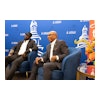Black, Hispanic Male Crisis Focus Of Higher Ed Summit
By David Pluviose
TAMPA, Fla.
For Dr. James H. Ammons, the crisis confronting Black and Hispanic males is obvious, but so is the solution.
“We, as leaders, have to step to the plate. [Black male] enrollment in prison cannot continue to supersede enrollment in higher education,” the chancellor of North Carolina Central University told his higher education colleagues during a recent summit aimed at finding solutions to the situation.
The conference, “Black, Brown, & College Bound: A Summit on African-American & Hispanic Males Meeting the Challenge of Higher Education,” concluded early this month. Sponsored by Hillsborough Community College, the summit addressed the alarming increase of Black male incarceration and the convergent decline in the numbers of Black men entering and graduating from college.
In his speech, Ammons elicited alternating gasps of shock and nods of agreement as he laid out a series of grim statistics concerning the plight of Black and Hispanic men.
In the past 40 years, the U.S. prison population has shifted from 70 percent White to 70 percent Black and Hispanic, he said. Additionally, one in three Black males is currently involved in the penal system. By 2020, if current trends hold, that figure will rise to more than 65 percent for Black men between the ages of 20 and 29.
“We will have more African-American men in prison than we did in slavery,” Ammons said, citing data from the book Merchandizing Prisoners: Who Really Pays for Prison Privatization? by Rutgers University Professor Byron Price.
To stem the tide, educators need to forge personal relationships with young Black students, he continued. “It’s not enough for us to work with them on the weekend in a setting on our campuses and never visit their homes and never talk to their family or their friends,” he said, adding that educators should “try to see the world as a young man does.”
Educators, at times, have to go beyond passively seeking relationships with students, especially in the critical early years, agreed Malcolm B. Williams, program manager for student support services at all-male Morehouse College.
“Intrusive counseling is how you connect with African-American young men. In the 21st century, these young men come to the academic environment with incredible degrees of distraction and more often than not, not with the tools that are going to help them navigate the first two years of the environment,” he said. “The only way to connect with these young men is by identifying staffers who are committed to the process and who have the passion to take the time to do the work required to connect with somebody’s son.”
Williams said the baby boomer generation “dropped the ball” and did not strive to form critical connections with Black youth.
“There are some academics and some scholars who will take issue with that, but we see the manifestation everyday, that’s why we’re having this conference,” he said. “In order for us to connect with these kids, we have to meet them where they are.”
Part of meeting Black youth where they are is creating space on hip-hop turf for colleges, said Dr. Tony D. Johnson, director of adult and community-based programs at Tallahassee Community College. Johnson said community colleges should run advertisements on hip-hop radio stations and not shy away from hitting the club scene via dance-floor ads.
Ammons agreed, saying, “We have to get over this uneasiness when it comes to dealing with hip-hop. We have to understand that this is the dominant part of our young people’s culture. In fact, some would suggest that it is their culture.”
Ammons also addressed a topic at the heart of two cases being deliberated by the U.S. Supreme Court — school resegregation. It’s already a reality, Ammons said, as African-American children make up less than 20 percent of children in the public school system but represent more than 50 percent of all special needs students. Of those 50 percent, eight out of 10 are male, and thus, according to data from Harvard’s Civil Rights Project, “African-American and Latino students are about twice as likely as White students to be educated in a restricted, or separate educational setting.”
© Copyright 2005 by DiverseEducation.com



















